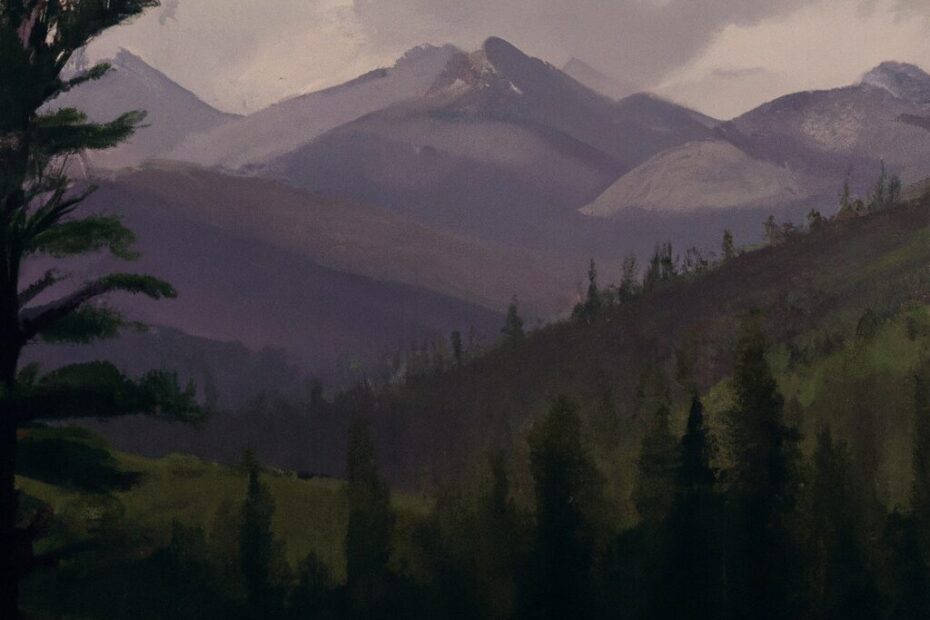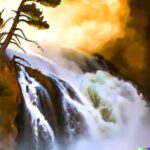If you’re planning a trip to Yellowstone National Park, you’re in for a treat! Home to mesmerizing geysers and an array of wildlife, Yellowstone offers visitors a unique opportunity to witness the wonders of nature.
In this article, we’ll delve into the fascinating world of geysers, exploring what causes them to erupt and the difference between geysers and hot springs. We’ll also take a look at the diverse wildlife that can be spotted in the park, along with the best times and places to see them. We’ll highlight the top spots for geyser and wildlife viewing, and provide some essential tips for a safe and responsible experience. So, pack your bags and get ready for an unforgettable adventure in Yellowstone!
What are Geysers and Where Can They Be Found in Yellowstone?
Yellowstone is home to some of the most captivating geysers on the planet, with their mesmerizing eruptions and unique geological formations providing an awe-inspiring glimpse into the region’s geothermal activity and volcanic landscape.
Geysers are formed by the intense heat from molten rock beneath the surface, creating immense pressure that forces water upwards in dramatic eruptions. This geological activity not only shapes the landscape, but also supports a delicate ecosystem.
The pristine environment of Yellowstone is home to diverse flora and fauna, showcasing the intricate balance of natural systems. The interactions between geothermal features, water bodies, and the surrounding flora and fauna highlight the ecological significance of Yellowstone. It serves as a reminder of the importance of conservation efforts to preserve this unique and biodiverse environment.
What Causes Geysers to Erupt?
The eruption of geysers in Yellowstone is driven by a combination of volcanic activity, hydrothermal vents, and the unique geological features of the region, resulting in the release of steam and water from thermal pools during a mesmerizing eruption.
These eruptions are a result of the intense heat from magma beneath the Earth’s surface, which superheats water and creates immense pressure.
The hydrothermal vents act as conduits for this superheated water, allowing it to rise to the surface. As the pressure builds, the water and steam are forcefully expelled, creating the spectacular eruptions that have captivated visitors for generations.
What is the Difference Between a Geyser and a Hot Spring?
While both geysers and hot springs in Yellowstone exhibit geothermal features, the crucial difference lies in their behavior, with geysers demonstrating intermittent, eruptive activity, contributing to the ecological balance and environmental sustainability of the volcanic landscape.
In contrast, hot springs release heated groundwater continuously, creating tranquil pools that support unique ecosystems.
Geysers, with their awe-inspiring eruptions, add to the ecological diversity by creating habitats for heat-resistant microorganisms.
As geothermal features, both geysers and hot springs play a significant role in sustaining the delicate balance of the geothermal ecosystem, showcasing the enduring power of natural geothermal processes.
What Types of Wildlife Can Be Seen in Yellowstone?
Yellowstone is renowned for its diverse wildlife, with a rich habitat that supports a remarkable array of species, showcasing the natural beauty and ecological significance of the region’s conservation efforts and protected habitats.
Yellowstone National Park is home to a diverse array of wildlife, including grizzly bears, gray wolves, lynx, and bison. These animals inhabit a variety of habitats, from alpine meadows to dense forests and geothermal areas. This rich biodiversity is a testament to the park’s unique ecosystem.
Not only does Yellowstone provide a home for a wide range of species, but it also plays a crucial role in conservation efforts. The park’s commitment to protecting endangered species has made it a vital sanctuary for threatened wildlife, highlighting its global ecological importance.
What are the Most Common Animals Found in Yellowstone?
In Yellowstone, visitors can encounter iconic wildlife such as bison, elk, bears, and wolves, exemplifying the region’s commitment to conservation efforts and serving as natural attractions that highlight the preservation of endemic species.
The presence of bison, often seen grazing in the grasslands or crossing roads, showcases the successful conservation efforts for this species, which was once on the brink of extinction. Similarly, the elk herds roaming through the valleys and meadows demonstrate the balance achieved in preserving their natural habitats.
The majestic bears and elusive wolves further add to the diverse array of wildlife that make Yellowstone a haven for wildlife enthusiasts and conservationists alike. These animals serve as a living testament to the importance of protecting and preserving the natural world for future generations to enjoy.
What are the Best Times and Places to Spot Wildlife in Yellowstone?
For an enriching wildlife experience, exploring Yellowstone during the early morning or late evening presents opportunities for memorable wildlife encounters, providing a window into the region’s habitat diversity, biodiversity, and scenic natural beauty that captivates eco-tourism enthusiasts.
During these times, the park comes alive with various species, including elk, bison, and bears, making it an ideal period for wildlife spotting. The Lamar and Hayden Valleys, as well as the Lamar River, are known for their rich wildlife population.
The Grand Canyon of the Yellowstone offers stunning vistas and the chance to spot bighorn sheep and osprey. Exploring these areas fosters an appreciation for the interconnectedness of the park’s ecosystems and the importance of preserving its natural wonders.
What are the Best Spots for Geyser and Wildlife Viewing in Yellowstone?
Yellowstone offers an array of captivating spots for geyser and wildlife viewing, providing visitors with natural attractions that inspire outdoor adventure, exploration, and a deep connection to the region’s pristine wilderness and ecological importance.
Yellowstone National Park boasts a plethora of must-see spots, including the famous Old Faithful Geyser. This iconic natural wonder never fails to impress with its regular and predictable eruptions.
For those interested in wildlife, Lamar Valley is a prime location for observing a diverse range of species, such as bison, elk, and grizzly bears, in their natural habitat. In addition to self-guided exploration, visitors can also participate in guided tours led by knowledgeable naturalist guides, gaining a deeper understanding of the park’s ecological significance and developing a greater appreciation for its natural wonders.
Old Faithful Geyser Basin
The Old Faithful Geyser Basin in Yellowstone stands as a testament to the region’s geological wonders, offering visitors a glimpse into a pristine wilderness sanctuary where the majestic eruptions of Old Faithful unfold in a captivating display of nature’s power and beauty.
This unique ecological site is a living, breathing example of the Earth’s dynamic forces. Its bubbling geysers, colorful hot springs, and steaming fumaroles capture the imagination of all who visit.
The basin’s geothermal features, formed over thousands of years, create a striking contrast against the wild, untamed landscape. This makes it a crucial habitat for various species, including rare fauna and flora that have adapted to this harsh yet beautiful environment.
Grand Prismatic Spring
The Grand Prismatic Spring in Yellowstone offers visitors a surreal experience, with its vibrant colors, diverse birdwatching opportunities, and breathtaking vistas making it a natural wonder that entices photography enthusiasts and nature lovers alike.
The spring’s radiant hues of blues, greens, and oranges create an otherworldly ambiance, captivating the eyes and captivating the hearts of all who gaze upon it.
Adding to its allure, the surrounding meadows and marshes provide a haven for various bird species, offering birdwatchers the chance to spot a myriad of feathered inhabitants in their natural habitat.
The striking landscapes surrounding the spring make it a prime location for photography enthusiasts, providing an endless array of picturesque vistas to capture and treasure.
Lamar Valley
Lamar Valley in Yellowstone provides a haven for diverse wildlife, underscoring the region’s commitment to habitat conservation and the preservation of ecological balance. This offers visitors an immersive encounter with the untamed beauty of nature’s inhabitants.
The valley’s expansive grasslands and meandering rivers support a rich tapestry of wildlife, including iconic species such as bison, elk, grizzly bears, and wolves. Through dedicated conservation efforts, the delicate balance of this ecosystem has been maintained, ensuring a thriving environment for these creatures. Visitors are afforded the rare opportunity to witness these majestic animals in their natural habitat, fostering a deep appreciation for the interconnectedness of all living beings within this pristine wilderness.
Hayden Valley
The Hayden Valley in Yellowstone offers memorable wildlife encounters, with the presence of bison, elk, and other iconic species creating natural attractions that captivate eco-tourism enthusiasts and offer a glimpse into the untamed beauty of wildlife in their natural habitat.
Visitors can witness the majestic herds of bison roaming the expansive meadows, catch a glimpse of the graceful elk grazing by the riverside, and marvel at the diverse avian species soaring through the vast skies.
The unique blend of diverse flora and fauna in Hayden Valley provides a captivating allure for nature enthusiasts and photographers, drawing them to experience firsthand the harmony and raw splendor of this untamed ecosystem.
Mammoth Hot Springs
Mammoth Hot Springs in Yellowstone offers a fascinating display of geothermal wonders. Its terraces and formations serve as testaments to the region’s commitment to conservation, preservation, and the preservation of geothermal marvels for future generations to cherish.
The otherworldly terraces, created by the constant flow of mineral-rich waters, are a sight to behold. They showcase the intricate work of nature’s artistry.
The region’s dedication to preserving these natural formations is evident through ongoing conservation and preservation efforts. This ensures the longevity of these geothermal marvels. Visitors can marvel at the vibrant colors and unique textures of the terraces, recognizing the importance of maintaining the delicate balance between human enjoyment and environmental protection in this stunning natural wonder.
Norris Geyser Basin
The Norris Geyser Basin in Yellowstone invites visitors on an immersive journey through its geysers, fumaroles, and other geothermal features, presenting opportunities for outdoor adventure and exploration amidst the captivating displays of natural phenomena.
As one wanders through the basin’s diverse landscape, they can witness steam rising from bubbling pools, marvel at the striking colors created by heat-loving microorganisms, and enjoy the serene beauty of the surrounding nature.
This unique environment offers a sense of wonder and discovery, drawing in nature enthusiasts, photographers, and adventure seekers alike. Visitors can engage in hiking trails that wind through the basin, providing a chance to witness the raw power and beauty of this geothermal wonderland.
Fountain Paint Pot
The Fountain Paint Pot in Yellowstone offers a mesmerizing blend of vibrant colors and volcanic activity, serving as a source of natural attractions and educational experiences that enrich visitors’ understanding of the region’s geological wonders and unique landscape.
The Fountain Paint Pot is a striking example of the geothermal features that make Yellowstone National Park so extraordinary. As visitors traverse the boardwalk, they are greeted by the bubbling mud pots, colorful hot springs, and the intermittent geyser eruptions, which create a dynamic and ever-changing landscape.
The contrast of the vivid reds, oranges, and yellows against the backdrop of the surrounding lush greenery captivates the senses, providing an immersive and visually stunning encounter with natural geological phenomena. Exploring the Fountain Paint Pot offers an opportunity for visitors to delve into the scientific and historical significance of the area’s volcanic activity, enhancing the overall educational experience.
West Thumb Geyser Basin
The West Thumb Geyser Basin in Yellowstone showcases a captivating blend of geological features and scenic beauty, providing opportunities for eco-tourism enthusiasts to immerse themselves in the region’s natural wonders and picturesque landscapes.
The basin features colorful hot springs, bubbling mud pots, and the striking blue hues of Yellowstone Lake, creating a surreal landscape that mesmerizes visitors. This unique environment offers a glimpse into the earth’s raw power and showcases the delicate balance of natural forces at work.
Visitors can explore boardwalk trails that wind through the basin, offering up-close encounters with steam vents and geothermal features. The area’s ecological significance makes it a must-visit for nature lovers seeking an immersive experience in a truly unique natural wonderland.
Black Sand Basin
The Black Sand Basin in Yellowstone presents a tapestry of geothermal wonders, inviting visitors on an outdoor adventure and exploration of its unique and mesmerizing natural phenomena that define the region’s captivating landscape.
The vibrant colors of the geothermal features, from the striking azure of the Sapphire Pool to the emerald hues of the Sunset Lake, offer a captivating contrast against the dark, iron-rich sand.
As visitors wander through this surreal landscape, they can witness the dynamic nature of the geothermal activity, with bubbling hot springs and erupting geysers creating an otherworldly atmosphere.
The juxtaposition of the stark black sand against the vivid geothermal features creates an unforgettable sensory experience, drawing visitors into the heart of Yellowstone’s natural marvels.
10. Firehole Lake Drive
The Firehole Lake Drive in Yellowstone unfolds a picturesque landscape adorned with geysers, offering a blend of scenic beauty and opportunities for outdoor adventure that captivate visitors with the region’s mesmerizing natural spectacles.
Visitors can witness the enchanting sight of geysers erupting in a dramatic display, sending plumes of steam and water skyward. The surrounding landscape boasts vibrant colors, thanks to the presence of thermophiles, enhancing the visual appeal of the area.
Hiking trails meander through this stunning terrain, providing an up-close experience with the geothermal wonders and unique flora. The juxtaposition of the bubbling hot springs against the tranquil waters creates a striking visual contrast, making Firehole Lake Drive a must-see destination for nature enthusiasts and adventurers alike.
What Are Some Tips for Safe and Responsible Geyser and Wildlife Viewing in Yellowstone?
When engaging in geyser and wildlife viewing in Yellowstone, it is essential to prioritize safe and responsible practices that preserve the region’s natural habitat, with a focus on conservation and environmental protection to ensure the sustainable enjoyment of these natural treasures for future generations.
When visiting Yellowstone National Park, it’s important to remember to maintain a respectful distance from wildlife. This means following designated trails and avoiding any actions that may disrupt their natural behaviors.
In addition, it’s crucial to adhere to park rules when it comes to viewing geysers and interacting with wildlife. This not only ensures the safety of visitors, but also protects the well-being of the animals.
By staying informed about the latest conservation efforts and actively contributing to environmental protection initiatives, visitors can play a vital role in preserving the delicate balance of Yellowstone’s ecosystem.
Frequently Asked Questions
Where are the best Yellowstone geysers wildlife viewing spots?
Some of the best Yellowstone geysers wildlife viewing spots include the Old Faithful Geyser, Mammoth Hot Springs, and the Grand Prismatic Spring.
What type of wildlife can I expect to see at Yellowstone’s geysers viewing spots?
At Yellowstone’s geysers viewing spots, you can expect to see a variety of wildlife such as bison, elk, bears, wolves, and various bird species.
Are there any specific times or seasons that are better for viewing wildlife at Yellowstone’s geysers?
The best time to view wildlife at Yellowstone’s geysers is during the summer months, from May to September. However, any time of the year can offer great viewing opportunities.
Do I need a permit to view wildlife at Yellowstone’s geysers?
No, a permit is not required to view wildlife at Yellowstone’s geysers. However, it is important to follow all park rules and regulations for the safety of both yourself and the animals.
Can I view wildlife on my own or do I need to book a tour?
You can view wildlife on your own at Yellowstone’s geysers, but guided tours are also available for a more in-depth and educational experience.
Are Yellowstone’s geysers viewing spots accessible to all visitors?
Many of Yellowstone’s geysers viewing spots are accessible to all visitors, but some may require hiking or walking on uneven terrain. It is important to check accessibility before planning your visit.
Last Updated on January 25, 2024 by Jon Waraas – Originally Posted: January 25, 2024

I’m Jon Waraas, and I’ve been navigating the online world since 2006. By day, I’m the proud owner of some eCommerce gems, and by night, I’m the voice behind the adventures on Waraas.Com.
My heart, however, belongs to the wild beauty of Yellowstone National Park. I’ve got a collection of websites dedicated to sharing the wonders of this natural masterpiece. Oh, and did I mention? I’m currently building my own cabin inside the ghost town of Gilmore, Idaho – a cabin with tales to tell!
When I’m not immersed in the digital realm, you’ll find me lacing up my boots for a good hike or setting up camp under the star-studded sky.




